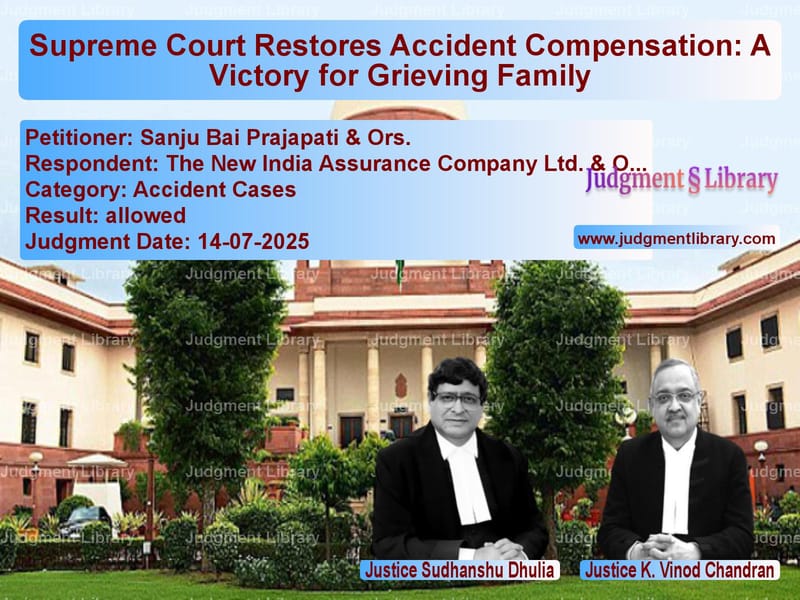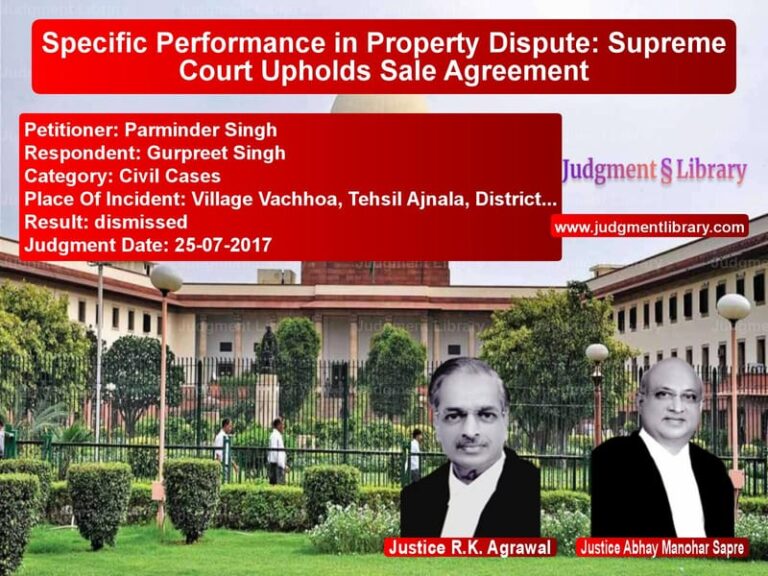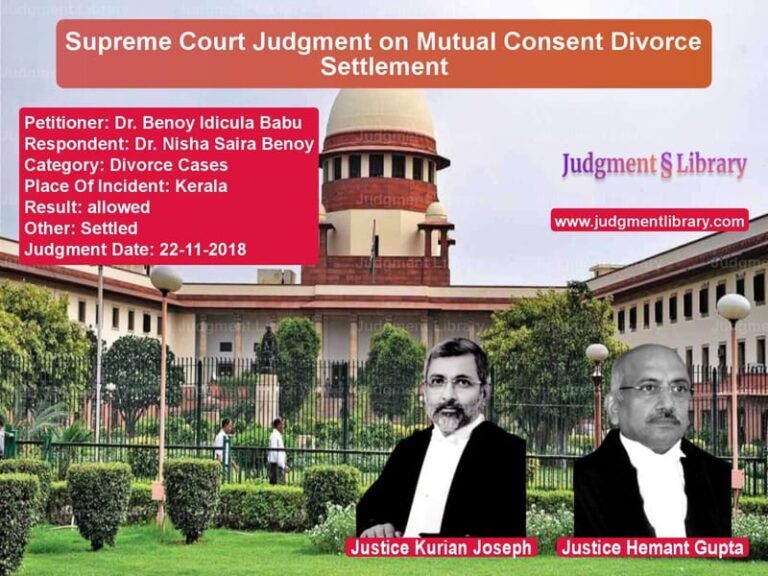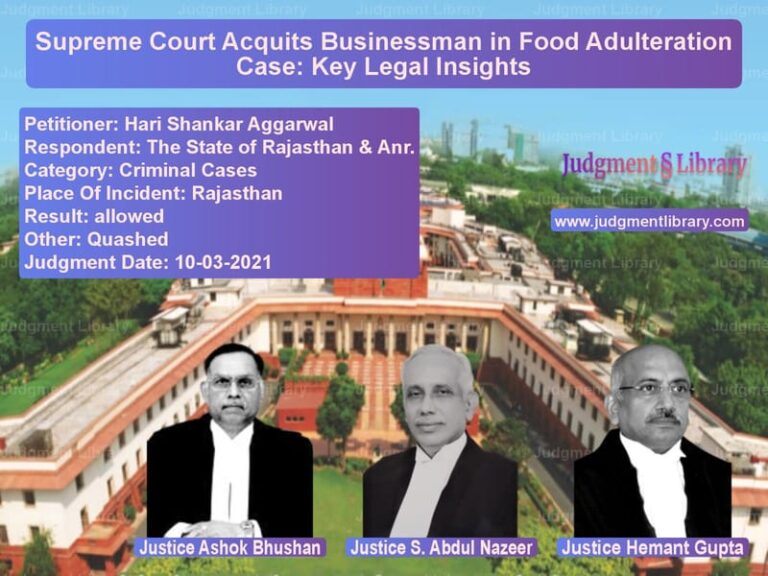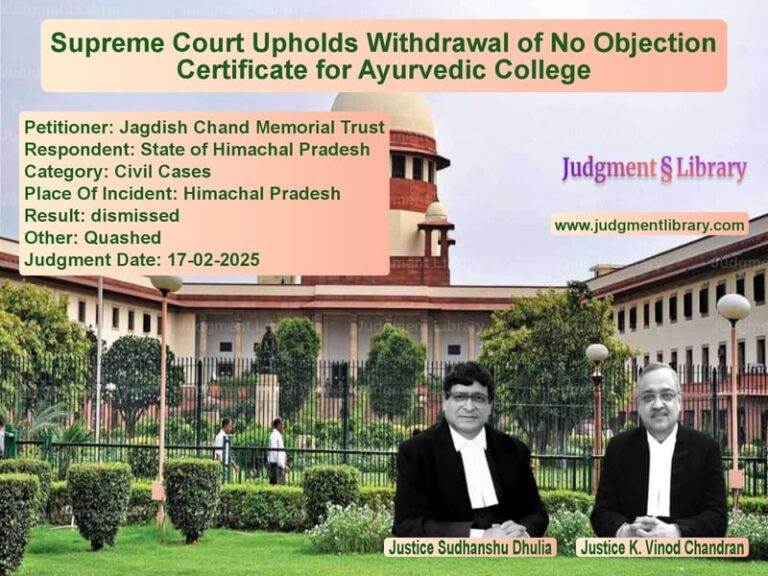Supreme Court Restores Accident Compensation: A Victory for Grieving Family
The tragic loss of a loved one in a road accident is devastating enough for any family, but when the legal system adds to their burden by denying rightful compensation, the pain becomes almost unbearable. This was the reality for Sanju Bai Prajapati and her three minor children, who found themselves fighting not just their grief but also a powerful insurance company that challenged their compensation claim. Their journey through India’s judicial system reveals much about how courts balance technical legal arguments with the fundamental need for justice for ordinary citizens.
The case began with a simple, yet tragic, event – a peon returning home from work on his motorcycle collided with another vehicle traveling at high speed. The injured man was rushed to the hospital but succumbed to his injuries, leaving behind a wife and three young children. What followed was a legal battle that would test the limits of evidence interpretation and the purpose of compensation laws.
The Motor Accident Claims Tribunal initially ruled in favor of the grieving family, awarding them compensation of Rs. 46,29,152. While this was less than the Rs. 53,79,820 they had claimed, the family accepted the award and did not appeal. However, their ordeal was far from over. The New India Assurance Company Ltd., the insurer of the vehicle allegedly involved in the accident, appealed to the High Court, which ultimately set aside the Tribunal’s award, leaving the family with nothing.
The insurance company’s arguments centered on technical grounds that questioned the very occurrence of the accident as described. The contention taken by the insurance company was that the alleged offending vehicle was not involved in the accident, especially on the ground that the FIR was registered three months after the accident. Additionally, the insurer argued that the driver did not have a driving license, and the vehicle did not have a permit to be used as a transport vehicle.
These arguments found favor with the High Court, which conducted a microscopic examination of the eyewitness testimony and found it wanting. The High Court focused on what it perceived as inconsistencies in the evidence, particularly regarding the eyewitness’s description of the vehicle. The Court noted that the witness couldn’t provide specific details like the vehicle’s color and registration number with perfect accuracy. More significantly, the High Court found the witness’s description of the registration plate – written in black on a white background – to be problematic since commercial vehicles typically have white lettering on yellow backgrounds. Combined with the three-month delay in filing the FIR, these factors led the High Court to doubt the entire incident as presented by the claimants.
When the matter reached the Supreme Court, the bench comprising Justices Sudhanshu Dhulia and K. Vinod Chandran took a markedly different view of the evidence. The Court recognized that in compensation cases, especially those involving death and injury, technicalities should not override substantive justice.
The Supreme Court carefully examined the chain of events and found the High Court’s reasoning flawed. The High Court, on an appeal by the insurance company, picked holes in the deposition of the eyewitness; according to us without just cause. This strong observation highlighted the Supreme Court’s view that the High Court had been unnecessarily strict in its assessment of the evidence.
The Supreme Court provided crucial context about the sequence of events that the High Court had overlooked. As far as the accident, it is seen that there is no dispute since a Murg report was made on intimation from the hospital which is produced as Annexure P-1 in which it was recorded that a person involved in a road accident was admitted to the hospital who died at 12:30 am. The accident is said to have occurred at 6 pm and the murg report was on the same day. This documentation created contemporaneous evidence of the accident, making the delay in FIR registration less significant.
The Court further explained the investigation process: We see from the FIR that based on the Murg report an investigation was carried out in the course of which the eyewitness was detected and Annexure P-2 FIR was registered. We do not find any reason to disbelieve the FIR, especially since the insurance company did not make any attempt to examine the investigating officer before the Tribunal. This observation placed the burden of proof appropriately – if the insurance company doubted the official investigation, it should have challenged it through proper channels rather than expecting the claimants to prove every detail beyond any conceivable doubt.
Regarding the eyewitness’s testimony, the Supreme Court took a pragmatic view. In the chaos of an accident, witnesses may not remember minute details like exact colors or registration numbers, but this doesn’t necessarily make their entire account unreliable. The Court implied that the High Court had applied standards of evidence more appropriate for criminal cases where guilt must be proven beyond reasonable doubt, rather than compensation cases which operate on the balance of probabilities.
The Supreme Court’s approach reflects a growing judicial recognition that compensation laws are social welfare legislation meant to provide relief to victims and their families. Technical defenses raised by insurance companies, while legally available, should not be allowed to defeat the fundamental purpose of these laws.
In its concluding remarks, the Court stated unequivocally: We find absolutely no reason to sustain the order of the High Court, therefore, we set aside the same. The Court directed that The amounts, with interest, as awarded by the Tribunal shall be disbursed to the claimants within a period of two months, which shall be equally apportioned in the name of the wife and three minor children. Recognizing the vulnerability of the minors, the Court added protective measures: If any of the minor children have not attained majority, the amount shall be kept in a fixed deposit, the interest of which can be disbursed to the mother who is the guardian.
This case represents more than just a victory for one family; it reinforces important principles in accident compensation jurisprudence. First, it affirms that courts should take a compassionate and practical approach when evaluating evidence in compensation cases. Second, it establishes that procedural irregularities like delayed FIR registration need to be viewed in context rather than as automatic grounds to dismiss genuine claims. Third, it reminds insurance companies that while they have the right to defend claims, this right should be exercised responsibly, not technically.
The judgment also highlights the Supreme Court’s role as the ultimate guardian of justice for ordinary citizens. When lower courts become excessively focused on technicalities, the Supreme Court often intervenes to restore balance and ensure that the spirit of the law prevails over its letter. In doing so, the Court not only delivers justice in individual cases but also guides lower courts on how to interpret laws in a manner that serves their intended purpose.
For families like Sanju Bai Prajapati’s, such judgments mean the difference between financial security and destitution. The compensation, while inadequate replacement for a lost husband and father, at least ensures that the children’s education and future aren’t compromised by the tragedy. It allows the family to grieve without the additional burden of financial uncertainty.
This case serves as an important precedent for future accident compensation claims, particularly those where insurance companies raise technical defenses. It reminds all stakeholders that the primary purpose of motor accident compensation laws is to provide relief to victims, not to create insurmountable procedural hurdles. As India’s roads become increasingly crowded and accidents more frequent, such clear judicial guidance is essential to ensure that the compensation system serves its social welfare purpose effectively.
Petitioner Name: Sanju Bai Prajapati & Ors..Respondent Name: The New India Assurance Company Ltd. & Ors..Judgment By: Justice Sudhanshu Dhulia, Justice K. Vinod Chandran.Judgment Date: 14-07-2025.Result: allowed.
Don’t miss out on the full details! Download the complete judgment in PDF format below and gain valuable insights instantly!
Download Judgment: sanju-bai-prajapati-vs-the-new-india-assura-supreme-court-of-india-judgment-dated-14-07-2025.pdf
Directly Download Judgment: Directly download this Judgment
See all petitions in Road Accident Cases
See all petitions in Compensation Disputes
See all petitions in Motor Vehicle Act
See all petitions in Negligence Claims
See all petitions in Third-Party Insurance
See all petitions in Insurance Settlements
See all petitions in Judgment by Sudhanshu Dhulia
See all petitions in Judgment by K. Vinod Chandran
See all petitions in allowed
See all petitions in supreme court of India judgments July 2025
See all petitions in 2025 judgments
See all posts in Accident Cases Category
See all allowed petitions in Accident Cases Category
See all Dismissed petitions in Accident Cases Category
See all partially allowed petitions in Accident Cases Category

